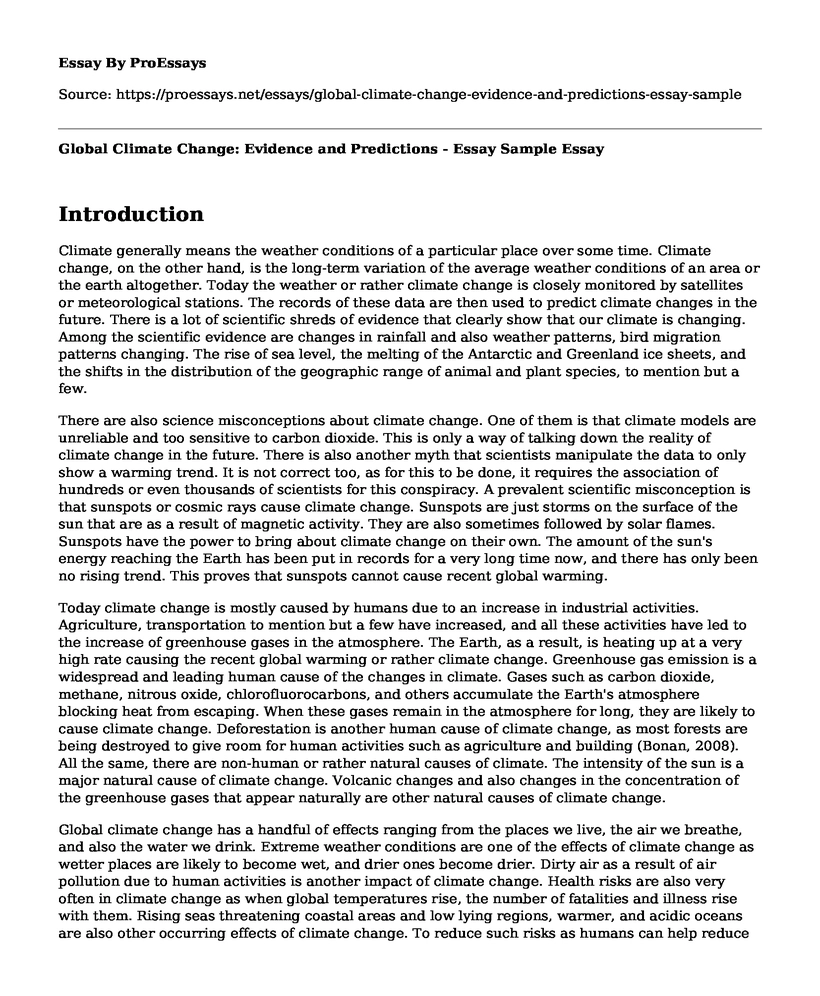Introduction
Climate generally means the weather conditions of a particular place over some time. Climate change, on the other hand, is the long-term variation of the average weather conditions of an area or the earth altogether. Today the weather or rather climate change is closely monitored by satellites or meteorological stations. The records of these data are then used to predict climate changes in the future. There is a lot of scientific shreds of evidence that clearly show that our climate is changing. Among the scientific evidence are changes in rainfall and also weather patterns, bird migration patterns changing. The rise of sea level, the melting of the Antarctic and Greenland ice sheets, and the shifts in the distribution of the geographic range of animal and plant species, to mention but a few.
There are also science misconceptions about climate change. One of them is that climate models are unreliable and too sensitive to carbon dioxide. This is only a way of talking down the reality of climate change in the future. There is also another myth that scientists manipulate the data to only show a warming trend. It is not correct too, as for this to be done, it requires the association of hundreds or even thousands of scientists for this conspiracy. A prevalent scientific misconception is that sunspots or cosmic rays cause climate change. Sunspots are just storms on the surface of the sun that are as a result of magnetic activity. They are also sometimes followed by solar flames. Sunspots have the power to bring about climate change on their own. The amount of the sun's energy reaching the Earth has been put in records for a very long time now, and there has only been no rising trend. This proves that sunspots cannot cause recent global warming.
Today climate change is mostly caused by humans due to an increase in industrial activities. Agriculture, transportation to mention but a few have increased, and all these activities have led to the increase of greenhouse gases in the atmosphere. The Earth, as a result, is heating up at a very high rate causing the recent global warming or rather climate change. Greenhouse gas emission is a widespread and leading human cause of the changes in climate. Gases such as carbon dioxide, methane, nitrous oxide, chlorofluorocarbons, and others accumulate the Earth's atmosphere blocking heat from escaping. When these gases remain in the atmosphere for long, they are likely to cause climate change. Deforestation is another human cause of climate change, as most forests are being destroyed to give room for human activities such as agriculture and building (Bonan, 2008). All the same, there are non-human or rather natural causes of climate. The intensity of the sun is a major natural cause of climate change. Volcanic changes and also changes in the concentration of the greenhouse gases that appear naturally are other natural causes of climate change.
Global climate change has a handful of effects ranging from the places we live, the air we breathe, and also the water we drink. Extreme weather conditions are one of the effects of climate change as wetter places are likely to become wet, and drier ones become drier. Dirty air as a result of air pollution due to human activities is another impact of climate change. Health risks are also very often in climate change as when global temperatures rise, the number of fatalities and illness rise with them. Rising seas threatening coastal areas and low lying regions, warmer, and acidic oceans are also other occurring effects of climate change. To reduce such risks as humans can help reduce climate changes through ways such as minimizing the usage of fossil fuels and instead of using renewable and cleaner sources of energy, reducing the use of cars as walking in itself is healthy for other distances, reducing water waste to save on carbon pollution to mention but a few. Climate change is caused by natural causes but mostly by human activities. Humans are hugely responsible for causing climate change and, therefore, should also highly contribute to reducing the risks that come around with these climate changes (Betsill, 2001). As much as some climate changes cannot be avoided, there are others that we can avoid and therefore do so for healthy and proper living.
References
Betsill, M. M. (2001). Mitigating climate change in US cities: opportunities and obstacles. Local environment, 6(4), 393-406. Retrieved from https://www.tandfonline.com/doi/abs/10.1080/13549830120091699
Bonan, G. B. (2008). Forests and climate change: forcings, feedbacks, and the climate benefits of forests. Science, 320(5882), 1444-1449. Retrieved from https://science.sciencemag.org/content/320/5882/1444.short
Cite this page
Global Climate Change: Evidence and Predictions - Essay Sample. (2023, Mar 21). Retrieved from https://proessays.net/essays/global-climate-change-evidence-and-predictions-essay-sample
If you are the original author of this essay and no longer wish to have it published on the ProEssays website, please click below to request its removal:
- Ecology Quiz Results Summary
- What Is Theme Park? Essay Example
- An Analysis of the Effects of Global Warming on Climatic Changes
- Public Health After Natural Disasters: A Case Study of Pakistan Flood 2010
- Essay on Environmental Factors and Aircraft Performance: A Debated Issue
- Essay Example on Sustainable Advancement: Impact on Environment and Per Capita Income
- Nature and Life: How Changing Nature Reflects Human Activities - Essay Sample







